
注意 :本篇教程已被 Attila Hegedüs 更新,可适用于 iOS 9 和 Swift 2.2。原始教程出自教程组成员 Steve Baranski。
如果你曾经想在自己的 app 中引入图表或图形,那么你应该已经考虑过下面两种选项:
自己写。 通过使用 Core Graphics 或者 Quartz 这样的框架编写全部的绘制代码。然而,这显然要花费大量的功夫。
买一个! 购买一个像 ShinobiControls 这样的商业型框架。这或许可以节省你的时间,但就要花钱啦。
但是如果你不想花费时间和精力从零开始写(代码),也不想花那么多钱,该怎么办呢?这时候第三个选项就派上用场了:使用开源库 Core Plot !
Core Plot 是一个2D绘制库,适用于 iOS,Mac OS X 和 tvOS。它使用了像 Quartz 和 Core Animation 这样的苹果应用框架,同时有着全面的测试覆盖,而且是遵照BSD这个比较宽松的许可证进行发布的。
在这个教程中,你将学习到如何使用 Core Plot 来创建饼图和柱状图,同时还会实现一些很酷的图表交互!
开始之前,你需要安装好 Xcode 7.3 ,同时对 Swift , Interface Builder 和 storyboards 有所了解。如果你对这些主题知之甚少,那么你应该在继续阅读本教程之前先学习一下我们其他的一些 教程 。
本教程同时还使用了 CocoaPods 去安装一些第三方的依赖库。如果你从来没使用过 CocoaPods 的话,那你还应该阅读一下我们关于它的 教程 。
在本教程中,你将创建一个在一定时间间隔内显示货币汇率(情况)的 App。从 这里 下载本教程的入门项目,把它解压缩后打开 SwiftRates.xcworkspace 。
项目的关键类在 App 这个文件夹和它的子文件夹下,它们包括了:
DataStore.swift 这是一个从 Fixer.io 请求货币汇率数据的帮助类。
Rate.swift 这是一个模型,表示给定日期里的货币汇率。
Currency.swift 这是一个表示货币类型的模型。支持的货币类型定义在 Resources/Currencies.plist 里。
MenuViewController.swift 这是一个app启动后展示的第一个视图控制器。它让用户选择一个货币作为基准然后再选两个对照。
HostViewController.swift 这是一个容器视图控制器,基于它的分段选项选中状态去控制展示 PieChartViewController 或者 BarGraphViewController 的内容。它还会去检查从 DataStore 请求来的汇率数据,因为它们也将在这个视图控制器里展现。
PieChartViewController.swift 这个控制器将用饼图的形式展示一个给定日期里的汇率。当然你首先要实现它!
BarGraphViewController.swift 这个控制器将以柱状图的形式展示几天的汇率。当你掌握绘制饼图的方法后,这个图简直小菜一碟!(看到我做的事情了吗?拜托,这真的有点意思!);]
构建并运行看看这个教程入门项目实际展示。
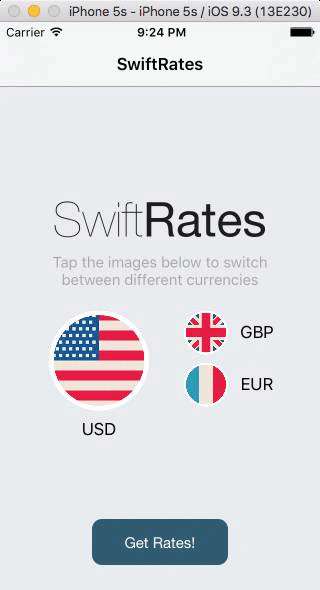
点选 Get Rates 导航去到 HostViewController 控制的视图然后可以切换分段选项。这个 app 确实还没有实现太多功能...;]
是时候用 Core Plot 开始真正的绘制了!
首先你需要安装 Core Plot,最简单的方式是通过 CocoaPods 安装。
把下面这行代码添加进你的 Podfile 文件, pod 'SwiftDate' 这行的后面:
pod 'CorePlot', '~> 2.1'
打开 Terminal (终端), cd 进入你的项目根目录,然后运行 pod install 。
安装完成后,构建项目。
没报错吧?很好,现在你可以随便使用 Core Plot 啦,感谢 CocoaPods。:]
如果你遇到了任何报错,可以尝试通过 sudo gem install cocoapods 更新一下 CocoaPods 然后再次运行 pod install 。
打开 PieChartViewController.swift 并添加下面这行引入:
import CorePlot
接着,添加下面这个属性:
@IBOutlet weak var hostView: CPTGraphHostingView!
CPTGraphHostingView 负责“托管”一个图表或图形。你可以把它想象成一个“图形容器”。
然后,把下面这个类扩展添加到文件结尾的花括号之后:
extension PieChartViewController: CPTPieChartDataSource, CPTPieChartDelegate {
func numberOfRecordsForPlot(plot: CPTPlot) -> UInt {
return 0
}
func numberForPlot(plot: CPTPlot, field fieldEnum: UInt, recordIndex idx: UInt) -> AnyObject? {
return 0
}
func dataLabelForPlot(plot: CPTPlot, recordIndex idx: UInt) -> CPTLayer? {
return nil
}
func sliceFillForPieChart(pieChart: CPTPieChart, recordIndex idx: UInt) -> CPTFill? {
return nil
}
func legendTitleForPieChart(pieChart: CPTPieChart, recordIndex idx: UInt) -> String? {
return nil
}
}
你将通过 CPTPieChartDataSource 为一个 Core Plot 图表提供数据,同时你会通过 CPTPieChartDelegate 得到用户交互的所有事件。随着教程递进,你将填满这些方法。
继续往下,打开 Main.storyboard 然后选择 PieChartViewController 窗口。
在这个视图上拖出一个新的 UIView ,然后把它的类更改成 CPTGraphHostingView ,并将它连接到 hostView 。
对这个视图的每个方向添加约束让撑满父视图,并确认没有设置外边距的约束:

设置一个你喜欢的背景色。我使用了透明度为92%的灰度颜色。
现在回到 PieChartViewController.swift ,在 viewDidLoad() 后面添加下面的方法:
override func viewDidLayoutSubviews() {
super.viewDidLayoutSubviews()
initPlot()
}
func initPlot() {
configureHostView()
configureGraph()
configureChart()
configureLegend()
}
func configureHostView() {
}
func configureGraph() {
}
func configureChart() {
}
func configureLegend() {
}
这样子就正好在子视图渲染好后设置了绘制策略。这里是你最早为视图设置框架大小的地方,接下来你将需要配置绘制策略。
initPlot() 里的每个方法都代表了一个设置绘制策略的阶段。这样子可以让代码保持其可维护性。
把下面这行添加进 configureHostView() :
hostView.allowPinchScaling = false
这行代码将对饼图禁用手势捏合缩放,它决定了托管视图对捏合手势是否会有反应。
接下来你需要添加一个图表到 hostView 。添加下面的代码到 configureGraph() 里吧:
// 1 - Create and configure the graph
let graph = CPTXYGraph(frame: hostView.bounds)
hostView.hostedGraph = graph
graph.paddingLeft = 0.0
graph.paddingTop = 0.0
graph.paddingRight = 0.0
graph.paddingBottom = 0.0
graph.axisSet = nil
// 2 - Create text style
let textStyle: CPTMutableTextStyle = CPTMutableTextStyle()
textStyle.color = CPTColor.blackColor()
textStyle.fOntName= "HelveticaNeue-Bold"
textStyle.fOntSize= 16.0
textStyle.textAlignment = .Center
// 3 - Set graph title and text style
graph.title = "\(base.name) exchange rates\n\(rate.date)"
graph.titleTextStyle = textStyle
graph.titlePlotAreaFrameAnchor = CPTRectAnchor.Top
下面对每个部分的代码进行分解:
首先你创建了一个 CPTXYGraph 的实例并指定它作为 hostView 的 hostedGraph 。这就将图表和托管视图联系起来了。
这个 `CPTGraph` 包括了你所看到的标准图表或图形的全部东西:边,标题,绘制相关数据,轴和图例。
默认情况下,`CPTXYGraph` 每个方向都有一个`20`的内边距。从我们这个项目来看这样并不好,所以你可以显式地将每个方向的内边距设置为`0`。
接下来就是通过创建和配置一个 CPTMutableTextStyle 实例来设置该图标标题的文本样式。
最后,就是给你刚刚创建的图表实例设置标题和其样式。同样你还需要指定标题锚点为该视图的上边界。
构建并运行app,你应该就可以看到这个图表的标题展示在屏幕上了:
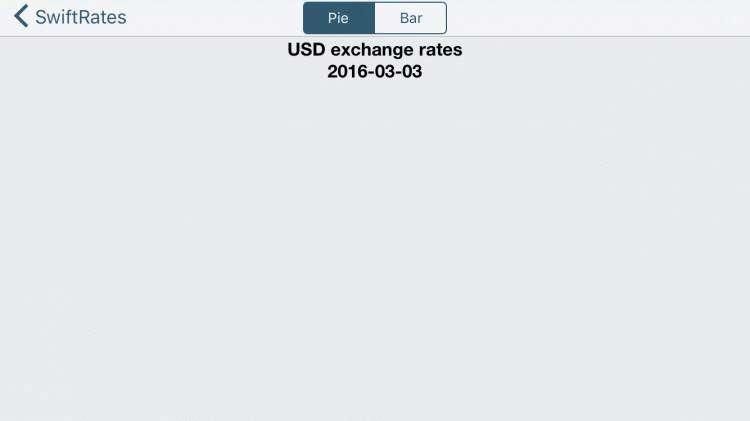
标题看起来不错,但你知道接下来什么会更棒吗?确确实实地看到饼图!
将下面的代码添加进 configureChart() :
// 1 - Get a reference to the graph
let graph = hostView.hostedGraph!
// 2 - Create the chart
let pieChart = CPTPieChart()
pieChart.delegate = self
pieChart.dataSource = self
pieChart.pieRadius = (min(hostView.bounds.size.width, hostView.bounds.size.height) * 0.7) / 2
pieChart.identifier = graph.title
pieChart.startAngle = CGFloat(M_PI_4)
pieChart.sliceDirection = .Clockwise
pieChart.labelOffset = -0.6 * pieChart.pieRadius
// 3 - Configure border style
let borderStyle = CPTMutableLineStyle()
borderStyle.lineColor = CPTColor.whiteColor()
borderStyle.lineWidth = 2.0
pieChart.borderLineStyle = borderStyle
// 4 - Configure text style
let textStyle = CPTMutableTextStyle()
textStyle.color = CPTColor.whiteColor()
textStyle.textAlignment = .Center
pieChart.labelTextStyle = textStyle
// 3 - Add chart to graph
graph.addPlot(pieChart)
下面看看这段代码做了什么:
首先获取了刚刚创建的图表的引用。
然后实例化一个 CPTPieChart ,将它的代理和数据源设置成这个视图控制器本身,并配置它的一些外观属性。
接着配置这个图表的边框样式。
配置它的文本样式。
最后,将这个饼图添加进刚刚引用的图表里。
如果现在重新构建并运行 app,你将看不到任何变化...因为你还需要实现这个饼图的代理和数据源。
首先,用下面这段替代了现在的 numberOfRecordsForPlot(_:) 方法:
func numberOfRecordsForPlot(plot: CPTPlot) -> UInt {
return UInt(symbols.count) ?? 0
}
这个方法决定了有多少块(部分)显示在饼状图上,它将为每一个标记显示一块(部分)。
接下来,用下面这段替换掉 numberForPlot(_:field:recordIndex:) :
func numberForPlot(plot: CPTPlot, field fieldEnum: UInt, recordIndex idx: UInt) -> AnyObject? {
let symbol = symbols[Int(idx)]
let currencyRate = rate.rates[symbol.name]!.floatValue
return 1.0 / currencyRate
}
饼图会使用这个方法得到索引为 recordIndex 的货币符号的“总”值。
你应该注意到这个值并 不是 一个百分比值。取而代之的是,这个方法计算出了相对基准货币的货币汇率:返回的这个 1.0 / currencyRate 的值是"一个单位的基准货币是多少价值的另外的对照货币"的汇率。
CPTPieChart 将查看计算每个分块的百分比值,这个值最终决定了这个分块占多大。
下面,用下面这行替代掉 dataLabelForPlot(_:recordIndex:) :
func dataLabelForPlot(plot: CPTPlot, recordIndex idx: UInt) -> CPTLayer? {
let value = rate.rates[symbols[Int(idx)].name]!.floatValue
let layer = CPTTextLayer(text: String(format: "\(symbols[Int(idx)].name)\n%.2f", value))
layer.textStyle = plot.labelTextStyle
return layer
}
这个方法返回了饼图分片的标签。期望的返回类型 CPTLayer 和 CALayer 有点相似,但是 CPTLayer 更加抽象,在 Mac OS X 和 iOS 上都能用,还提供了额外的绘图细节供 Core Plot 使用。
这里,创建并返回一个 CPTLayer 的子类 CPTTextLayer 去展示文本。
最后,将下面这段代码替换掉 sliceFillForPieChart(_:, recordIndex:) 去添加分片的颜色:
func sliceFillForPieChart(pieChart: CPTPieChart, recordIndex idx: UInt) -> CPTFill? {
switch idx {
case 0: return CPTFill(color: CPTColor(componentRed:0.92, green:0.28, blue:0.25, alpha:1.00))
case 1: return CPTFill(color: CPTColor(componentRed:0.06, green:0.80, blue:0.48, alpha:1.00))
case 2: return CPTFill(color: CPTColor(componentRed:0.22, green:0.33, blue:0.49, alpha:1.00))
default: return nil
}
}
构建并运行,你就将看到一个漂亮的饼图了:
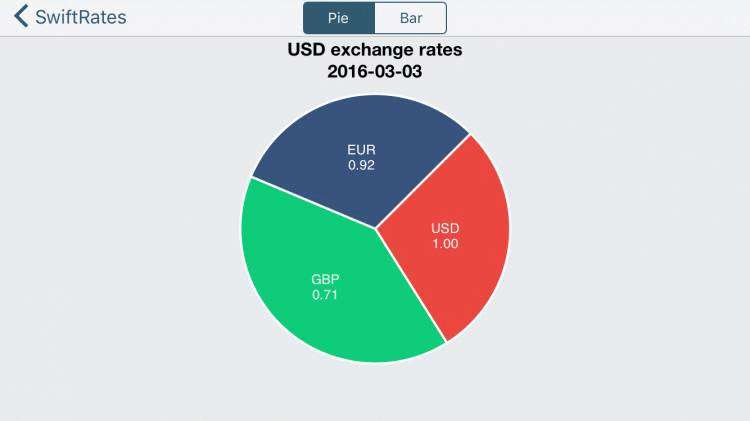
这个图表看上去相当不错,但是添加一个图例应该会让它更棒。接下来你将学习怎么添加一个图例到这个图表里。
首先,用下面这段替换掉 configureLegend() :
func configureLegend() {
// 1 - Get graph instance
guard let graph = hostView.hostedGraph else { return }
// 2 - Create legend
let theLegend = CPTLegend(graph: graph)
// 3 - Configure legend
theLegend.numberOfColumns = 1
theLegend.fill = CPTFill(color: CPTColor.whiteColor())
let textStyle = CPTMutableTextStyle()
textStyle.fOntSize= 18
theLegend.textStyle = textStyle
// 4 - Add legend to graph
graph.legend = theLegend
if view.bounds.width > view.bounds.height {
graph.legendAnchor = .Right
graph.legendDisplacement = CGPoint(x: -20, y: 0.0)
} else {
graph.legendAnchor = .BottomRight
graph.legendDisplacement = CGPoint(x: -8.0, y: 8.0)
}
}
同样你也需要为每个分片提供图例的数据。
要提供数据,就用下面这段替换掉 legendTitleForPieChart(_:recordIndex:) :
func legendTitleForPieChart(pieChart: CPTPieChart, recordIndex idx: UInt) -> String? {
return symbols[Int(idx)].name
}
构建并运行,你就会得到一个“带图例的”图表啦。
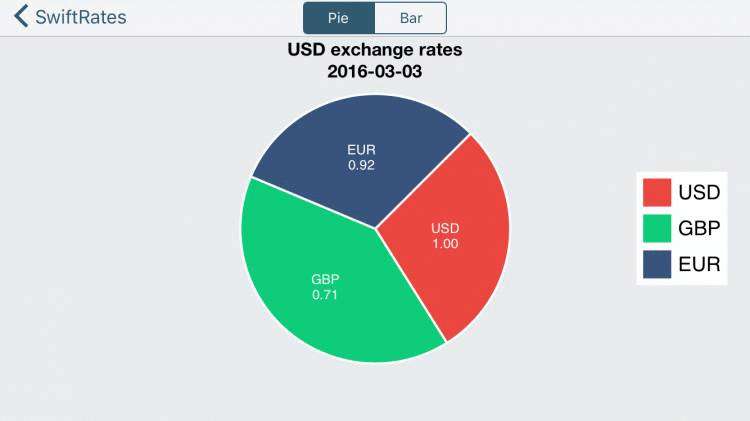
看样子你已经是绘制饼图的专家啦,但是时候去搞一个柱状图了!
打开 BarGraphViewController 并添加下面这行:
import CorePlot
接着,再添加下面这行:
@IBOutlet var hostView: CPTGraphHostingView!
其实就和饼图一样,托管视图将承载这个柱状图的展示。
下一步,添加下面这些属性:
var plot1: CPTBarPlot!
var plot2: CPTBarPlot!
var plot3: CPTBarPlot!
这里声明了三个 CPTBarPlot 类型的属性,它们就相当于展示在图表中的每种货币。
注意到同样也有三个 IBOutlet 标签和三个 IBAction 方法已经被定义了,你都可以在 storyboard 上看到它们。
最后,把下面这个类扩展添加到文件末尾:
extension BarGraphViewController: CPTBarPlotDataSource, CPTBarPlotDelegate {
func numberOfRecordsForPlot(plot: CPTPlot) -> UInt {
return 0
}
func numberForPlot(plot: CPTPlot, field fieldEnum: UInt, recordIndex idx: UInt) -> AnyObject? {
return 0
}
func barPlot(plot: CPTBarPlot, barWasSelectedAtRecordIndex idx: UInt, withEvent event: UIEvent) {
}
}
这和创建饼图的过程太像了:通过 CPTBarPlotDataSource 为柱状图提供数据,通过 CPTBarPlotDelegate 捕捉用户交互事件。你只需要复制粘贴就好了。
就像刚刚创建饼图时候一样,再次需要通过界面生成器把托管视图添加进去。
回到 Main.storyboard 并选择 BarGraphViewController 窗口。
在视图上拖拽出一个新的 UIView ,将它的类更改为 CPTGraphHostingView 并将其输出连接到控制器里的 hostView 。
通过 UtilitiesSize Inspector (那个 刻度尺 选项卡)将它的框架更新到下面那样:
X = 0, Y = 53, Width = 600, Height = 547
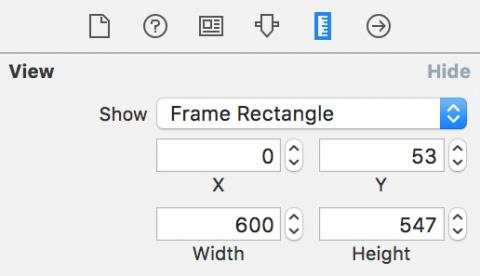
添加它和所有相邻元素的约束,确认没有设置 外边距约束 。
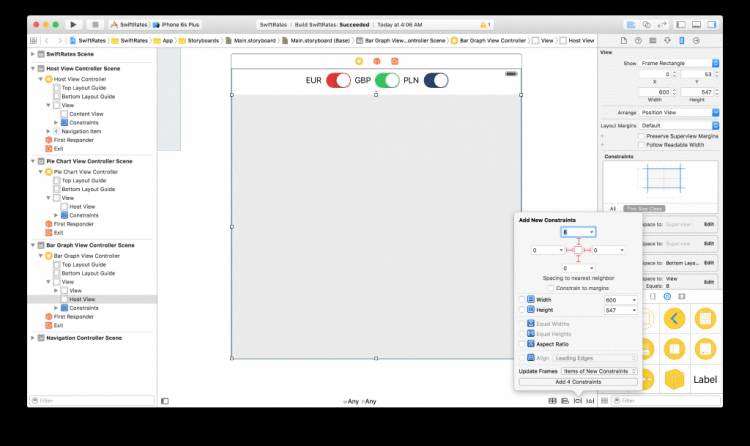
最后,设置一个你喜欢的背景颜色。我再次用了92%透明度的灰度颜色。
既然 UI 已经通过上面的学习全部弄好了,是时候去绘制一个柱状图了。
首先,回到 BarGraphViewController ,你需要一对常量属性。把下面这段添加到其他属性之前:
let BarWidth = 0.25
let BarInitialX = 0.25
你还需要一个帮助函数去计算最高的率值。把下面这段添加到 updateLabels() 之后:
func highestRateValue() -> Double {
var maxRate = DBL_MIN
for rate in rates {
maxRate = max(maxRate, rate.maxRate().doubleValue)
}
return maxRate
}
接着,把下面的方法添加到 highestRateValue() 之后:
override func viewDidLayoutSubviews() {
super.viewDidLayoutSubviews()
initPlot()
}
func initPlot() {
configureHostView()
configureGraph()
configureChart()
configureAxes()
}
func configureHostView() {
}
func configureGraph() {
}
func configureChart() {
}
func configureAxes() {
}
是不是看上去很眼熟?是的,这些和之前的结构完全一样。
下面这行添加到 configureHostView() 里:
hostView.allowPinchScaling = false
因为你不需要捏合缩放,所以你应该再次把它禁用。
接着,把下面那么多行代码添加到 configureGraph() 里:
// 1 - Create the graph
let graph = CPTXYGraph(frame: hostView.bounds)
graph.plotAreaFrame?.masksToBorder = false
hostView.hostedGraph = graph
// 2 - Configure the graph
graph.applyTheme(CPTTheme(named: kCPTPlainWhiteTheme))
graph.fill = CPTFill(color: CPTColor.clearColor())
graph.paddingBottom = 30.0
graph.paddingLeft = 30.0
graph.paddingTop = 0.0
graph.paddingRight = 0.0
// 3 - Set up styles
let titleStyle = CPTMutableTextStyle()
titleStyle.color = CPTColor.blackColor()
titleStyle.fOntName= "HelveticaNeue-Bold"
titleStyle.fOntSize= 16.0
titleStyle.textAlignment = .Center
graph.titleTextStyle = titleStyle
let title = "\(base.name) exchange rates\n\(rates.first!.date) - \(rates.last!.date)"
graph.title = title
graph.titlePlotAreaFrameAnchor = .Top
graph.titleDisplacement = CGPointMake(0.0, -16.0)
// 4 - Set up plot space
let xMin = 0.0
let xMax = Double(rates.count)
let yMin = 0.0
let yMax = 1.4 * highestRateValue()
guard let plotSpace = graph.defaultPlotSpace as? CPTXYPlotSpace else { return }
plotSpace.xRange = CPTPlotRange(locationDecimal: CPTDecimalFromDouble(xMin), lengthDecimal: CPTDecimalFromDouble(xMax - xMin))
plotSpace.yRange = CPTPlotRange(locationDecimal: CPTDecimalFromDouble(yMin), lengthDecimal: CPTDecimalFromDouble(yMax - yMin))
下面是这段代码逻辑的拆解:
首先,实例化一个 CPTXYGraph ,实际上就是一个柱状图,并将它关联到 hostView 。
然后声明一个 简约的白色 默认主题并为了展示 XY 轴去设置左侧和下方的内边距。
接着设置文本样式,图表标题以及标题位置。
最后,配置 CPTXYPlotSpace ,它负责将设备的坐标系映射到图表的坐标系。针对这个图表,你正在绘制三个使用了相同坐标系的汇率。然而,也有可能每个条形图的坐标系都是 分离 的。你还要在坐标系中假定一个最大最小值汇率范围。在后面的教程中,你将学习到怎么样在不提前设定范围的情况下自动调节空间大小。
既然已经创建好图表了,那是时候增加一些绘制方法进去了!把下面的代码添加到 configureChart() 里:
// 1 - Set up the three plots
plot1 = CPTBarPlot()
plot1.fill = CPTFill(color: CPTColor(componentRed:0.92, green:0.28, blue:0.25, alpha:1.00))
plot2 = CPTBarPlot()
plot2.fill = CPTFill(color: CPTColor(componentRed:0.06, green:0.80, blue:0.48, alpha:1.00))
plot3 = CPTBarPlot()
plot3.fill = CPTFill(color: CPTColor(componentRed:0.22, green:0.33, blue:0.49, alpha:1.00))
// 2 - Set up line style
let barLineStyle = CPTMutableLineStyle()
barLineStyle.lineColor = CPTColor.lightGrayColor()
barLineStyle.lineWidth = 0.5
// 3 - Add plots to graph
guard let graph = hostView.hostedGraph else { return }
var barX = BarInitialX
let plots = [plot1, plot2, plot3]
for plot: CPTBarPlot in plots {
plot.dataSource = self
plot.delegate = self
plot.barWidth = BarWidth
plot.barOffset = barX
plot.lineStyle = barLineStyle
graph.addPlot(plot, toPlotSpace: graph.defaultPlotSpace)
barX += BarWidth
}
接着来看看上面的代码干了什么:
实例化每个条形图并设置它们的填充色。
实例化一个代表每个条形图的外部边框的 CPTMutableLineStyle 实例。
给每个条形图提供“共同配置”。该配置包括设置数据源和代理,宽度和每个条形图在坐标系中的相对位置(左右)以及线条样式,最后,添加这个坐标系到图表当中。
虽然还不可以看到柱状图展示出来,但通过构建 app 可以去验证目前为止是否所有代码都可以正确编译通过。
为了确切看到柱状图展示数据出来,需要去实现提供图表所需数据的代理方法。
用下面这行替换掉 numberOfRecordsForPlot(:_) :
return UInt(rates.count ?? 0)
该方法返回了应该展示的记录的总数。
下面这段替换掉 numberForPlot(_:field:recordIndex:) :
if fieldEnum == UInt(CPTBarPlotField.BarTip.rawValue) {
if plot == plot1 {
return 1.0
}
if plot == plot2 {
return rates[Int(idx)].rates[symbols[0].name]!.floatValue
}
if plot == plot3 {
return rates[Int(idx)].rates[symbols[1].name]!.floatValue
}
}
return idx
CPTBarPlotField.BarTip 的值表明了柱状图的相对大小。在你需要取回数据的时候可以使用保留属性计算出汇率, recordIndex 对应了利息率的位置。
构建并运行,你应该可以看到和下面这张图一样的情况:
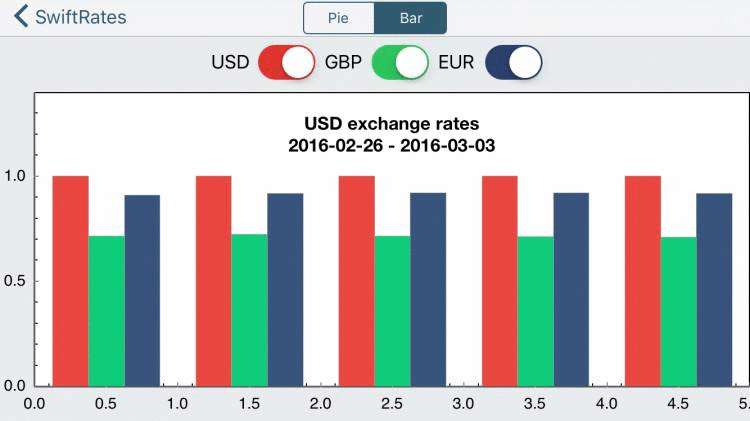
已经快完成了!但请注意还没有任何东西指明每个坐标轴是代表什么意思。
要解决这个问题,把下面这段添加进 configureAxes() :
// 1 - Configure styles
let axisLineStyle = CPTMutableLineStyle()
axisLineStyle.lineWidth = 2.0
axisLineStyle.lineColor = CPTColor.blackColor()
// 2 - Get the graph's axis set
guard let axisSet = hostView.hostedGraph?.axisSet as? CPTXYAxisSet else { return }
// 3 - Configure the x-axis
if let xAxis = axisSet.xAxis {
xAxis.labelingPolicy = .None
xAxis.majorIntervalLength = 1
xAxis.axisLineStyle = axisLineStyle
var majorTickLocatiOns= Set
var axisLabels = Set
for (idx, rate) in rates.enumerate() {
majorTickLocations.insert(idx)
let label = CPTAxisLabel(text: "\(rate.date)", textStyle: CPTTextStyle())
label.tickLocation = idx
label.offset = 5.0
label.alignment = .Left
axisLabels.insert(label)
}
xAxis.majorTickLocatiOns= majorTickLocations
xAxis.axisLabels = axisLabels
}
// 4 - Configure the y-axis
if let yAxis = axisSet.yAxis {
yAxis.labelingPolicy = .FixedInterval
yAxis.labelOffset = -10.0
yAxis.minorTicksPerInterval = 3
yAxis.majorTickLength = 30
let majorTickLineStyle = CPTMutableLineStyle()
majorTickLineStyle.lineColor = CPTColor.blackColor().colorWithAlphaComponent(0.1)
yAxis.majorTickLineStyle = majorTickLineStyle
yAxis.minorTickLength = 20
let minorTickLineStyle = CPTMutableLineStyle()
minorTickLineStyle.lineColor = CPTColor.blackColor().colorWithAlphaComponent(0.05)
yAxis.minorTickLineStyle = minorTickLineStyle
yAxis.axisLineStyle = axisLineStyle
}
简单地说,上面的代码首先为轴线和标题定义了样式,然后,为图表添加坐标轴的设置并配置好 x 轴和 y 轴的一些属性。
构建并运行就可以看到这些改动的结果了。
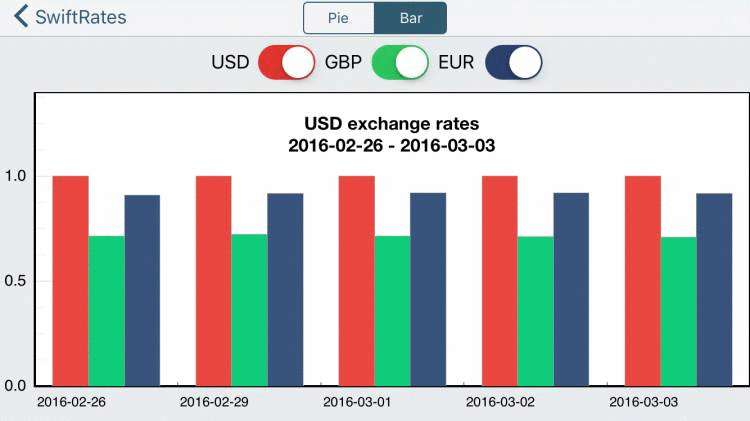
更棒了对吧?唯一的缺陷在于这个坐标轴太简单了,没办法从这儿得到一个准确的汇率展示。
你可以修复这个问题以便当用户点按在一个单独的柱状图时,这个 app 可以展示这个图表示的汇率。为了实现它,需要增加一个新的属性:
var priceAnnotation: CPTPlotSpaceAnnotation?
然后把下面的代码添加到 barPlot(_:barWasSelectedAtRecordIndex:) :
// 1 - Is the plot hidden?
if plot.hidden == true {
return
}
// 2 - Create style, if necessary
let style = CPTMutableTextStyle()
style.fOntSize= 12.0
style.fOntName= "HelveticaNeue-Bold"
// 3 - Create annotation
guard let price = numberForPlot(plot,
field: UInt(CPTBarPlotField.BarTip.rawValue),
recordIndex: idx) as? CGFloat else { return }
priceAnnotation?.annotationHostLayer?.removeAnnotation(priceAnnotation)
priceAnnotation = CPTPlotSpaceAnnotation(plotSpace: plot.plotSpace!, anchorPlotPoint: [0,0])
// 4 - Create number formatter
let formatter = NSNumberFormatter()
formatter.maximumFractiOnDigits= 2
// 5 - Create text layer for annotation
let priceValue = formatter.stringFromNumber(price)!
let textLayer = CPTTextLayer(text: priceValue, style: style)
priceAnnotation!.cOntentLayer= textLayer
// 6 - Get plot index
var plotIndex: Int = 0
if plot == plot1 {
plotIndex = 0
}
else if plot == plot2 {
plotIndex = 1
}
else if plot == plot3 {
plotIndex = 2
}
// 7 - Get the anchor point for annotation
let x = CGFloat(idx) + CGFloat(BarInitialX) + (CGFloat(plotIndex) * CGFloat(BarWidth))
let y = CGFloat(price) + 0.05
priceAnnotation!.anchorPlotPoint = [x, y]
// 8 - Add the annotation
guard let plotArea = plot.graph?.plotAreaFrame?.plotArea else { return }
plotArea.addAnnotation(priceAnnotation)
这里需要一些解释:
不要给一个隐藏的柱状图展示注解,而当图没有设置隐藏属性的时候,在把切换开关整合到图表之后,你就将实现它了。
这里还要为你的注解创建一个文本样式。
得到指定柱状图的汇率,然后如果它不存在一个注解对象,就创建一个。
如果没有数值格式化的方法还需要创建一个,因为在汇率展示的时候需要先格式化它。
创建一个使用这个格式化汇率的文本层,并将注解的内容层设置到这个新的文本层上。
获取你将展示的注解需要放置的柱状图索引。
基于这个索引计算注解的位置,并给使用这个计算位置注解设置 anchorPlotPoint 的值。
最后,将注解添加到图表上。
构建并运行。每次当你点按图表中的一个柱体时,该柱体所表示的值就应该正好在其上方弹出来。
棒极了! :]
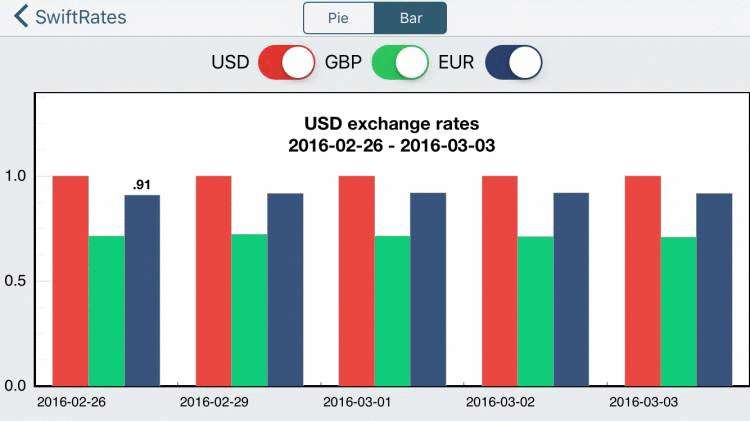
这个柱状图看起来很棒,但屏幕最上方的切换开关并没有起什么作用,是时候改动它们了。
首先,需要添加一个帮助方法,把下面这段添加到 switch3Changed(_:) 之后:
func hideAnnotation(graph: CPTGraph) {
guard let plotArea = graph.plotAreaFrame?.plotArea,
priceAnnotation = priceAnnotation else {
return
}
plotArea.removeAnnotation(priceAnnotation)
self.priceAnnotation = nil
}
这段代码首先简单地移除了一个如果存在的注解。
下一步,你希望用户通过切换开关展示一个给定的货币汇率柱状图。
要做到这个功能,用下面这段替换到 switch1Changed(_:) , switch2Changed(_:) 和 switch3Changed(_:) 的实现。
@IBAction func switch1Changed(sender: UISwitch) {
let on = sender.on
if !on {
hideAnnotation(plot1.graph!)
}
plot1.hidden = !on
}
@IBAction func switch2Changed(sender: UISwitch) {
let on = sender.on
if !on {
hideAnnotation(plot2.graph!)
}
plot2.hidden = !on
}
@IBAction func switch3Changed(sender: UISwitch) {
let on = sender.on
if !on {
hideAnnotation(plot3.graph!)
}
plot3.hidden = !on
}
这个逻辑相当简单。如果开关设置了关闭,相关的图和其可见的注解就将被隐藏,而如果设置为开启,则图就会被设置为可见。
构建并运行。现在你可以在图表中随意切换每个柱状图的展示了。教程至此已经完成了很不错的工作!
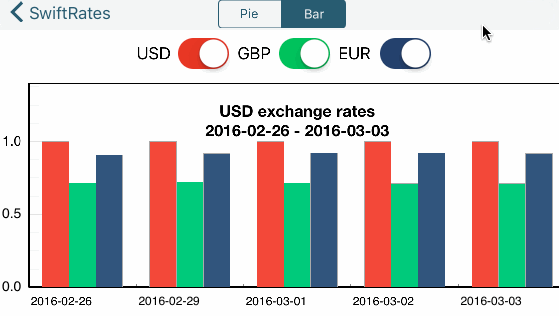
你可以从 这里 下载一个已完成的项目。
哇哦,相当有趣!这个教程重点介绍了 Core Plot 的强大功能并希望提示了你该怎么在你自己的 apps 里使用它。
当然还可以参考 Core Plot 仓库获取更多的信息,包括文档,例子和一些小贴士。
还有,如果你对这个教程有任何的问题或者评论,欢迎加入下面的论坛进行讨论。
祝你有个快乐的绘图过程!
阅读原文

 京公网安备 11010802041100号 | 京ICP备19059560号-4 | PHP1.CN 第一PHP社区 版权所有
京公网安备 11010802041100号 | 京ICP备19059560号-4 | PHP1.CN 第一PHP社区 版权所有